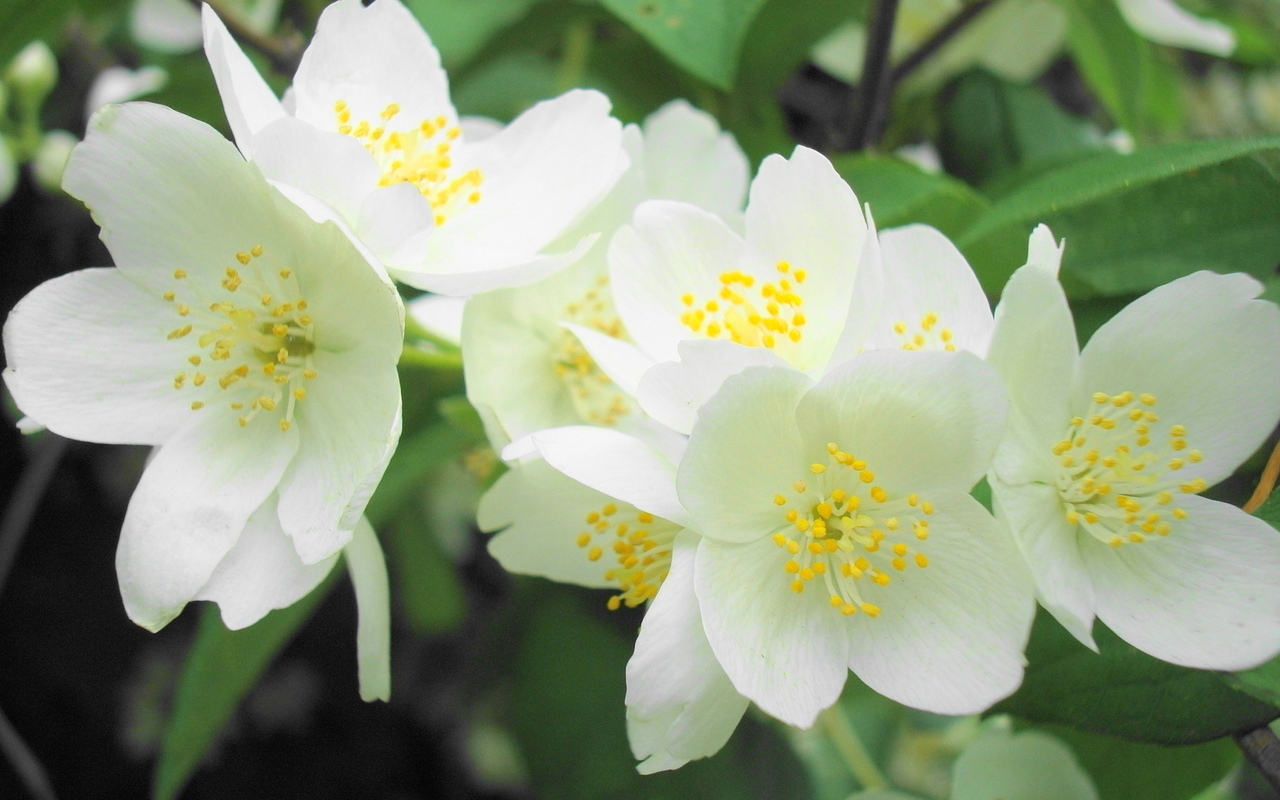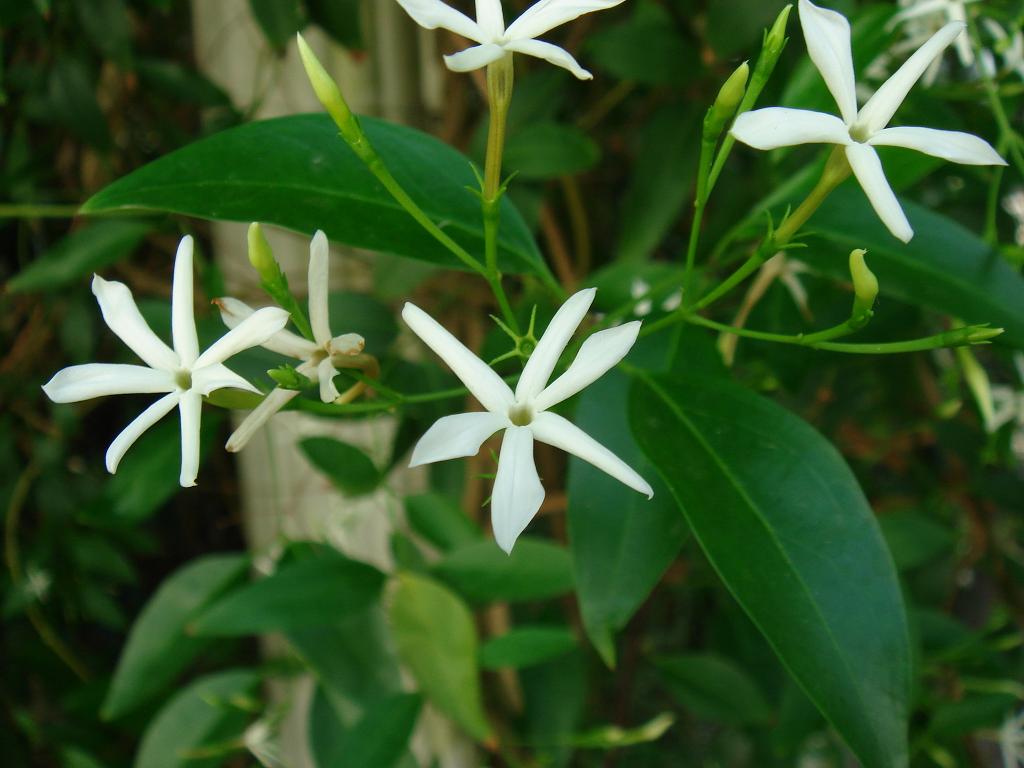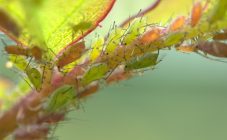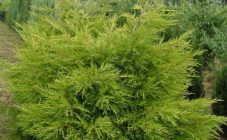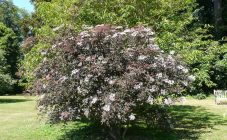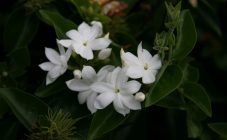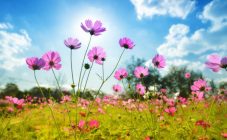Jasmine is one of the most spectacular flowers. During the flowering period, the plant is covered with countless flowers. Falling down, the petals create a white carpet on the ground. An active floral scent spreads far beyond the garden.
Description of culture
Often jasmine is confused with chubushnik, as visually and even in aroma they are similar. However, the plants are not related. Chubushnik is a representative of the Hortensia family, while jasmine belongs to the Olive family.
The main signs of what jasmine looks like:
- Evergreen shrub with a straight or curly trunk;
- Jasmine leaves are firm, dark green, simple in shape;
- Flowers are single or collected in an umbrella inflorescence. Location - lateral or apical;
- Plant height - from 0.1 m (indoor species) to 4 m (wild shrubs);
- Jasmine flowers are usually white or creamy, sometimes pinkish and yellow;
- On the threads of the buds, fruits grow - berries that are not suitable for food;
- The ampel view allows you to grow jasmine as a decoration for the interior of a house or make it the main link in the landscape design of a personal plot.
The homeland of jasmine is tropical and subtropical regions. In the wild, the bush is found in Australia, Africa, Asia, the Mediterranean and South America. Despite this, the plant has taken root well in temperate latitudes, however, the variety of species is not so great. In Russia and Europe, most often you can find only 2 species. Even in regions with harsh climates, you can grow jasmine - a flower at home. Due to its strong aroma, the plant is recommended to be placed in the kitchen.
Today, several hundred types of jasmine are known. The first difference according to which varieties of jasmine are divided is color. There are three categories: yellow, white and pink jasmine. Any of these species has its own characteristics, both in appearance and in care. In addition, the varieties differ in the height of the bush and the structure of the main parts of the plant.
The most famous varieties:
- Flattened is a miniature shrub with light green foliage. The flowers have a very bright aroma and a slight purple hue;
- Shrub - a tall bush (up to 1.5 m) with straight flexible twigs. Paired leaves, lateral inflorescences. Refers to the type Yellow Jasmine;
- Lerata is a very tall bush (3.5-4 m). The peculiarity of the variety is a delicate mint aroma. It has long green branches and dark green leaves. Jasmine color - white;
- Jasmine multiflorous is a creeping and branching shrub, up to 3 m tall. Has a second name - Polyant. All parts of the plant are covered with fluff, which is why they have a characteristic gray tint. Flowers are collected in bunches and have the shape of stars. The peculiarity of the variety is year-round flowering. In addition, inflorescences are located throughout the plant. The aroma is delicate and pleasant. The buds are pink, when opened, they are white with a pink stem;
- Medicinal - due to its thin climbing structure, it looks like grass. The branches are long, tangled. The leaves grow in pairs. The flowers are small with thin legs. 4 petals are located opposite each other in the form of a cross. All parts of this jasmine are used for medicinal purposes;
- Indian is a decorative jasmine. It has a lush appearance due to the curly stems. Other variations of the name are Sambac or Jasmine Terry (due to the shape of the flower). The main hybrids are Beauty of India, Mali Chat and Arabian Knights. With proper care, the shrub can bloom all year round;
- Chinese jasmine is a liana whose branches grow up to 10 m in length. The green part has a rich color.During flowering, a very noble aroma comes from the plant;
- Jasmine yellow-leaved Aureus belongs to the chubushnik family. Fast growing shrub. Height - 2-3 m, crown shape - rounded. It got its name because of the peculiarity of changing the color of the leaves from bright green to yellow. Throughout the season, the plant looks spectacular, first because of the abundant flowering, then because of the unusual color of the foliage. Does not require special growing conditions;
- Strawberry jasmine is another representative of the chubushnik. Compact shrub up to 1.5 m in height. The leaves are small. The peculiarity of the species is a delicate strawberry aroma and slow development (the growth of branches is no more than 7 cm per year);
- Red jasmine Bissa is a rather large bush with branches reaching 2 m in length. The leaves are simple, covered with fluff below, smooth above. Flowers are solitary, sometimes collected in an inflorescence of 3 pieces. They have a bright pink to red tone. Active flowering occurs in May;
- Moscow (aka Terry or Garden) is a medium-sized shrub (up to 2 m). It has very large flowers (about 5 cm in diameter). The aroma during flowering is bright fruity. It attracts gardeners not only with aesthetics, but also with long flowering up to 1 month. For good development, requires a fertile, drained soil;
- Large-flowered is an evergreen liana-like plant. The branches grow up to 10 m in length. It has bare shoots. Flowers - white star-shaped, growing one at a time. The foliage is dense, dark;
- Variegated - garden chubushnik, a favorite of summer residents. It has a very presentable appearance due to its unusual foliage. A jasmine-like bush up to 2.5 m high. The leaves are bordered in an uneven white color, because of this, bizarre patterns are created. The flowers are simple white. Flowering duration is 20-25 days.
Growing
Planting and grooming basics are the same for all species and varieties. The recommended time for planting a young seedling in the open field is spring or late autumn. The landing pattern is pretty simple and does not require any special skills. Preference should be given to light, fertile land. There should be no stagnation of water. If the groundwater is close, it is necessary to create a drainage layer. The depth of the landing hole is half a meter. A handful of nitrophosphate is poured onto the bottom.
The main activities for caring for the bush:
- Loosening of the trunk circle to improve aeration - twice a season;
- Abundant watering in the summer - 30 liters per 1 bush every two days. With a lack of moisture, foliage withers;
- Mulching - to retain moisture and prevent weed growth;
- Forming and sanitary pruning, removal of dry buds. This procedure is very important, since the thickening of the crown leads to a decrease in flowering volumes. Pruning is done in early spring and at the end of flowering. Removal of faded flowers - as needed. With a formative pruning, branches growing inward are removed, with a rejuvenating one, all branches are shortened by half, with a sanitary one, dry, weak and diseased branches are completely removed;
- Top dressing is required in the spring. At this time, ash and nitrophosphate are introduced. You can water the bush with a mullein (proportion - 1:10). For each bush, you need to add 20 liters of mullein 1 time per month. Mineral dressings should include potassium, phosphorus and nitrogen. You can take a ready-made complex fertilizer, dilute with water and add 10 liters of solution under each bush.
- Prevention and protection against diseases and pests.
Jasmine is easy to reproduce, it can be done in several ways:
- Seeds. It is recommended to harden the material before sowing. After that, the seeds are sown in a container with nutrient soil and covered with sand. Put glass on top or wrap it with foil. Watering is carried out through a spray bottle. Seedlings appear in 1.5-2 weeks. Sprouts dive in pots and shade from direct rays.In the phase of 3-5 true leaves are planted in the main place;
- Cuttings. Annual growth (branches) must be cut in the fall and stored in a dry, dark place. In the spring, the cuttings are planted immediately in open ground. The cut should be made obliquely. There should be 2-3 buds on the handle. The most important thing is to maintain constant soil moisture;
- Layers. The procedure is done before the kidneys swell. You need to dig up the ground near the bush, make a groove 1-15 m long and lay a branch there. You can fix the layering with iron pins or wire. Cover the layers with earth on top. When the shoots grow about 15 cm, they need to be spud. The second hilling should be done when the shoot grows another 10 cm. You can transfer the layers to a new place already in October;
- Division of the bush. When the bush has grown, it is removed from the soil with roots, divided into two parts and planted in a new place.
Indoor (kitchen) jasmine is also picky and easy to care for, like a real street bush. He does not need to create a special temperature regime. Short-term exposure to direct sunlight tolerates well. But to avoid scalding, the bush should be shaded on the south side. In the summer it is necessary to water abundantly and irrigate from a spray bottle, since the flower does not like dryness. In winter, the watering procedure is reduced, depending on the conditions of detention. For irrigation, use settled water at room temperature. The plant is transplanted every 3 years. For transplanting, you can take a universal soil and be sure to put a layer of expanded clay (1-2 cm) on the bottom of the peas for drainage.
Useful properties of culture
In addition to the obvious aesthetic effect, culture has a number of useful properties:
- The scent of jasmine - the effect on a person is very great. The aroma envelops and soothes, adjusts to a positive mood. It is a natural antidepressant;
- Use in cosmetology. Since ancient times, jasmine pomace has been valued as an effective anti-aging remedy. Jasmine cosmetics soothe and moisturize dehydrated sensitive skin;
- Jasmine tea has a tonic effect. Tea or a decoction of petals is especially useful for women on critical days, as it relieves pain and soothes the nervous system;
- Roots, stems and flowers are used in the treatment of cirrhosis, hepatitis, asthma and other serious diseases.
Jasmine has a number of contraindications:
- Allergies and intolerances;
- High pressure;
- Diseases of the stomach;
- Pregnancy and lactation.
About diseases and pests
- Darkening of the buds and reduced flowering - too dry air and soil. You can get rid of the problem by increasing the volume and frequency of watering;
- Curled leaves - lack of moisture and too bright lighting. It is necessary to create a shadow around the bush, for example, build a canopy;
- The bush does not bloom when the acidity of the soil does not suit it. You can get rid of the problem by alkalizing the soil. Dolomite flour can be added at the rate of 300 g / m2. You can move the bush to an area with a more suitable type of soil;
- Rot and spotting occurs when there is too much rainfall in the summer. Fungal diseases need to be treated with fungicides, for example, Teldor. Skor and Maxim preparations are highly effective against rot. These products do not burn leaves and flowers. Other types of fungus do not attack jasmine.
- The active aroma of this crop repels most pests. However, in a particularly dry summer, when flowering activity decreases, the shrub can be attacked by scale insects, spider mites and aphids. You can fight insects using folk methods: treatment with soapy water or infusion of potato tops. You can spray the bushes with a strong stream of water or add a ladybug to the bush. She is a natural enemy of aphids. In case of severe damage, you need to connect chemical agents: Fitoverm, Aktofit, Jaguar.
Useful information about the plant
- Jasmine flowers are a symbol of happiness in Indonesia, so they are always used during the wedding ceremony;
- Flowers exude the strongest aroma after sunset. Under the influence of sunlight, the inflorescences are slightly closed during the day, and at night they bloom in full force;
- In Asian countries, an alcohol-based jasmine drug is common. It is believed that its use saves from the bites of poisonous insects and snakes and makes a person fearless;
- The strong scent of jasmine helps get rid of most insects;
- In landscape design, jasmine bushes look especially advantageous against the background of lilacs, next to ponds and gazebos.
Jasmine is the pride and joy of the gardener. It looks beautiful and blooms, while not causing much trouble. Even a beginner can grow a bush.
